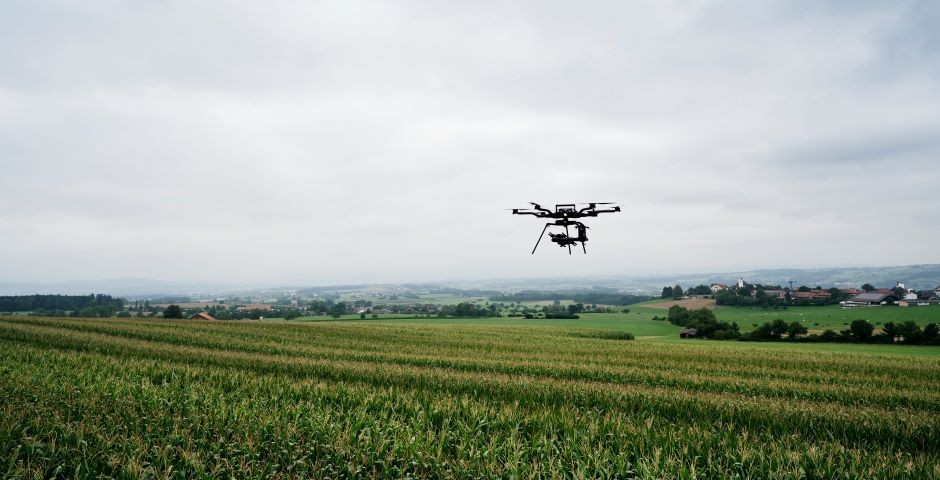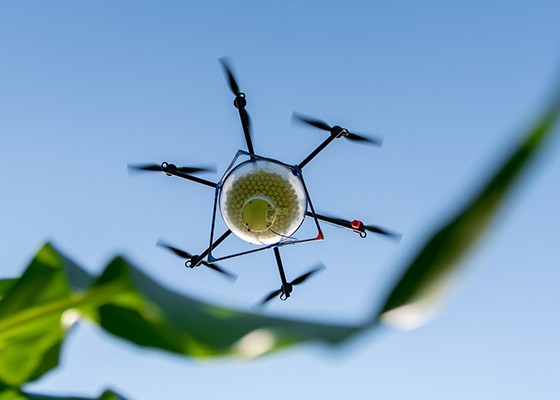
Climate change affects ecosystems and thus the livelihoods of farmers and foresters. These new challenges require new solutions.
Digitisation has great potential and the start-up, Agrarpiloten, uses drones as practical assistants.
Combating corn pests
The corn borer is a rather unpopular type of moth. Its larvae eat through the stems of corn plants until they snap. This often leads to reduced crop yields. Instead of spraying this pest with poison, the modern-day approach is to set a natural enemy against it: the ichneumon fly. To avoid damaging corn plants, the ichneumon fly’s eggs must be laboriously spread by hand or, much more efficiently, by drone. To this end, an inventor has developed a special drone for Agrarpiloten, which automatically spreads balls filled with ichneumon fly larvae.

The heaxcopter, specially manufactured for Agrarpiloten, in use. (Source: Agrarpiloten)
Agrarpiloten provides a comprehensive service. In the agricultural sectors, farms can register their fields by entering the relevant GPS coordinates. The radio-controlled and GPS-guided drone takes off and, under the supervision of a pilot, sprays the field evenly with ichneumon fly larvae. Based on the IoT, the system is largely autonomous, making it highly efficient and cheap compared to previous practices.
The data transmission from the software to the drone and back again uses the mobile network. Most farms are located far from urban areas, with some even in remote mountain areas. A reliable network providing total coverage is therefore a key factor.
This type of efficiency-enhancing solution is essential to ensuring the future survival of Swiss agriculture, because global warming favours the proliferation of pests. In light of climate change, the problem of pests will therefore become more rather than less serious, which is why the sector must keep pace with new technological developments.
Bark beetles are eating Swiss forests
Bark beetles affect Swiss forests. These small animals eat their way along trees under the bark, creating entire tunnel systems. They actually belong to the natural forest ecosystem. In especially dry weather and warm temperatures, however, they reproduce disproportionately thereby tipping the balance in the forest. This phenomenon is also a direct result of climate change and will therefore become increasingly worse. 2019 saw the second-highest infestation of bark beetles ever recorded in Swiss forests. If a tree is attacked by bark beetles, it simply dries out. Foresters must chop it down as quickly as possible before the beetles move on to the surrounding trees.
Once again, cutting-edge technology offers solutions for the future. With its multi-copters and autonomous surface planes, Agrarpiloten provides a bark beetle monitoring service. In only a short time, the drone flies systematically over large wooded areas taking pictures. With the help of machine learning, the software creates a directory of all the trees in the forest, with each tree assigned its own identification number. The system recognises and saves the type, height, circumference and exact coordinates of each tree. This procedure is carried out at regular six-week intervals and the recordings from the different flights are compared to one another. Accordingly, the system recognises when trees change appearance over time and identifies over 200 different signs of disease. It is therefore possible to detect disease and a bark beetle infestation.

Through the use of drones, Agrarpiloten can obtain a bird’s-eye view of large wooded areas in a very short time. (Source: Agrarpiloten)
The main advantage of this is that the system can detect an infestation up to four weeks earlier. The multispectral camera operates in the near infra-red range enabling it to detect tree dryness before it can be seen by the naked eye. Because foresters can remove a diseased tree much earlier, the surrounding trees enjoy better protection against the beetles. Furthermore, the wood of the tree has suffered less damage at such an early stage, thereby making it possible to avoid a considerable reduction in value. If the system registers a bark beetle infestation or other disease in a tree or group of trees, it informs the relevant forester via the accompanying app. This shows the forester on a map where the affected trees are located so that they can take targeted action. The comprehensive information is transmitted to the app via the mobile network. Nationwide availability of 5G, with a corresponding high-performance connection, will help ensure quicker data transmission in the future.
The innovative approach adopted by Agrarpiloten also has advantages beyond monitoring bark beetles. The exact directory of the forest and all its trees makes foresters’ work fundamentally more efficient. If, for example, an order for spruce wood is received, the foresters know in no time at all where the relevant trees are located and which ones would have to be felled anyway. The system also proves to be useful with regard to storms and bad weather. Thanks to the tree directory, it is possible to obtain a very precise estimation of the damage caused. The Agrarpiloten software compares pictures before and after a storm, identifies which trees have been destroyed and can thus calculate the monetary losses. This aspect is particularly important for the future, because climate change will cause increasingly violent storms accompanied by more extensive damage.
Digital agriculture is gaining ground
Agrarpiloten is constantly expanding its range of services. At present, in addition to using drones to fight corn borers and monitor bark beetles, the company also uses a drone to spread pesticides and as a solution for under- and over-sowing.
Latest news about Swisscom
Subscribe to News
Contact us
Address
Swisscom
Media Relations
Alte Tiefenaustrasse 6
3048 Worblaufen
Postal address:
Postfach, CH-3050 Bern
Switzerland
Contact
Tel. +41 58 221 98 04
media@swisscom.com
Other contacts
Contributing to sustainability
With its innovative services, Agrarpiloten makes an effective contribution to achieving the UN Sustainable Development Goals (SDG)

SDG 13: Coping with the consequences of climate change, such as violent storms or more frequent pest infestations, will be facilitated and organised more efficiently.

SDG 15: It will be possible to combat pests, such as bark beetles and corn borers, ecologically, efficiently and without the use of pesticides.
